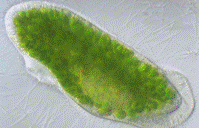Papers in the Biological Sciences
Document Type
Article
Date of this Version
6-2011
Citation
The Southwestern Naturalist (June 2011) 56(2): 147-153. DOI: http://dx.doi.org/10.1894/F02-JB-17.1
Abstract
Although most cacti that have been studied are long lived, following individually marked plants in Boulder County, Colorado, for >7 years, we determined that average life span of Opuntia macrorhiza, the western prickly pear, is 3 years. A few individuals probably live >10 years. Vegetative reproduction, produced by rooting of cladodes, exceeded reproduction by germination and establishment from seeds. Both types of new recruits, from vegetative reproduction and seeds, had higher death rates than established plants. Size and frequency of flowering increased with age, although size both increased and decreased, sometimes dramatically, between years. Flowering correlated more strongly with size than with age. Estimates of population growth indicated these populations were stable (λ = 1.02). Elasticities suggest that the population was most sensitive to survival of smaller plants.
RESUMEN—Si bien la mayoría de los cactus estudiados son perennes, luego del seguimiento por más de 7 años de plantas marcadas individualmente en el condado de Boulder en Colorado, encontramos que el promedio de vida de plantas de Opuntia macrorhiza, el nopal raizudo, es de 3 años. Pocos individuos probablemente viven más de 10 años. La multiplicación vegetativa a través del enraizamiento de cládodes excedió a la reproducción por germinación y establecimiento a partir de semillas. Ambos tipos de nuevos reclutas, sean provenientes de multiplicación vegetativa o de semillas, evidenciaron mayores tasas de mortandad que las plantas ya establecidas. El tamaño y frecuencia de floración aumentaron con la edad, pero el tamaño de plantas aumentó y decreció, a veces notablemente, entre años. La floracióón se correlacionó más fuertemente con tamaño que con edad. Las estimaciones de crecimiento poblacional indicaron que estas poblaciones fueron estables (λ = 1.02). Las elasticidades sugieren que la población fue más sensible a la supervivencia de las plantas más pequeñas.
Included in
Biodiversity Commons, Plant Sciences Commons, Population Biology Commons, Terrestrial and Aquatic Ecology Commons


Comments
Copyright 2011, Kathleen H. Keeler and Brigitte Tenhumberg. Published by the Southwestern Association of Naturalists.